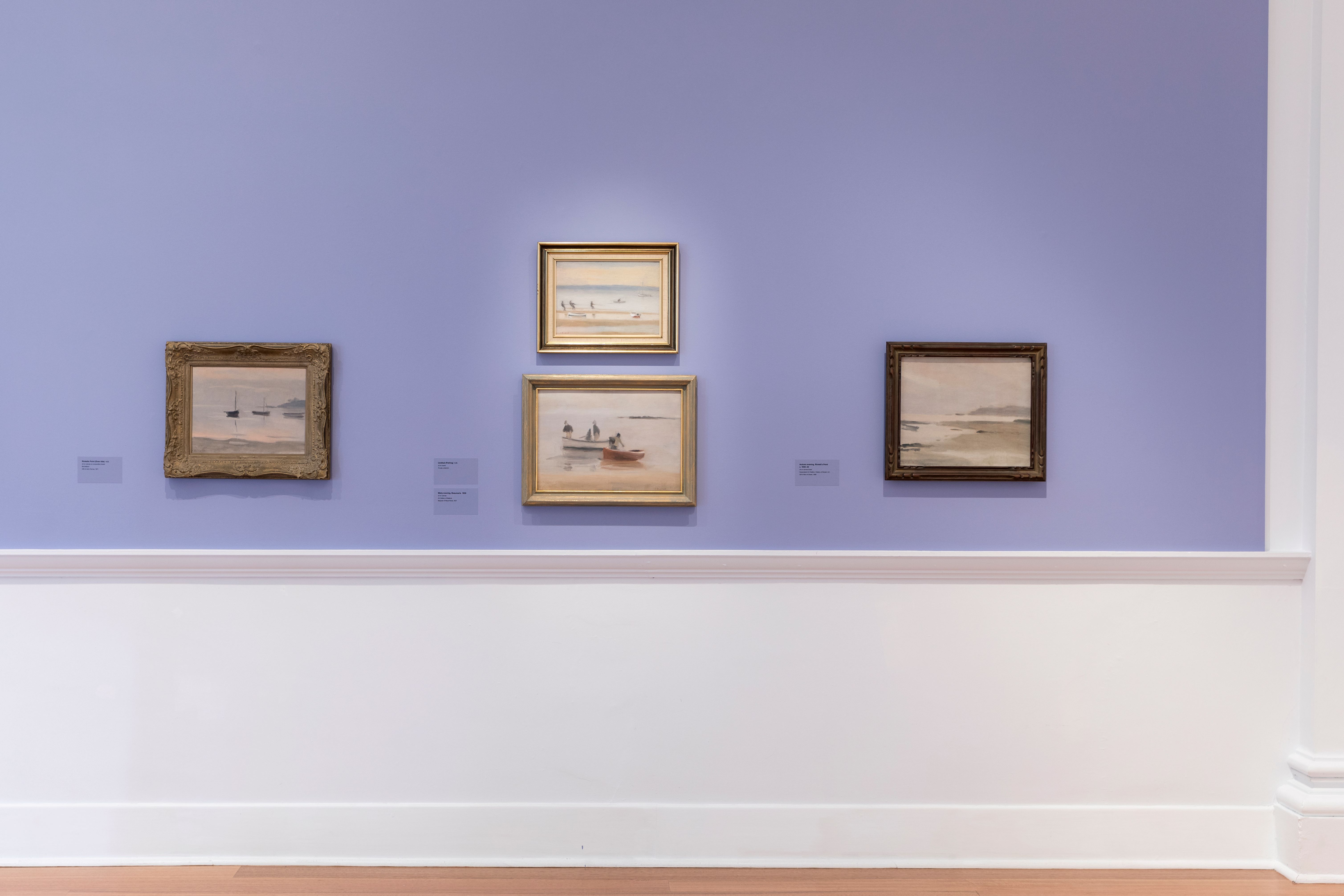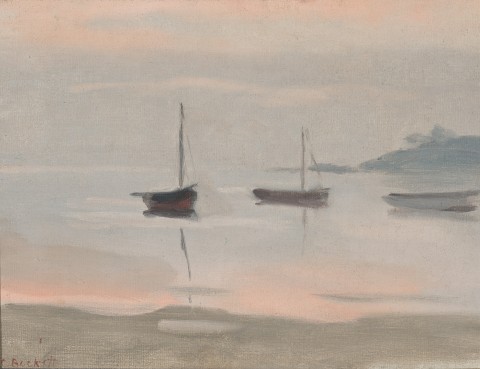BOATS AT SUNSET, 1930
CLARICE BECKETT
oil on canvas on board
31.0 x 41.0 cm
signed lower left: C. Beckett
bears inscription verso: Eventide / by / Clarice Beckett / 23 / WAXED
original John Thallon frame, Melbourne
Athenaeum Gallery, Melbourne
John Farmer, Victoria, acquired from the above in 1930
McClelland Collection, McClelland Sculpture Park and Gallery, Langwarrin, gifted from the above in 1971 (label attached verso, as ‘Ricketts Point, Beaumaris’)
Clarice Beckett, Athenaeum Gallery, Melbourne, 15 – 25 October 1930, cat. 23
All Our Own Work, McClelland Gallery, Langwarrin, December 1977 – January 1978, cat. 36 (as ‘Rickett’s Point, Beaumaris’)
All Our Own Work, McClelland Gallery, Langwarrin, 8 – 31 July 1979, cat. 8 (as ‘Rickett’s Point, Beaumaris’)
Clarice Beckett: Atmosphere, Geelong Gallery, Victoria, 1 April – 9 July 2023, cat. 64 (as ‘Ricketts Point (Even tide)’)
Smith, J., Clarice Beckett: Atmosphere, Geelong Gallery, Victoria, 2023, cat. 64, p. 81 (illus., as ‘Ricketts Point (Even tide)’)
We are grateful to Peter Perry for his assistance with this catalogue entry.
In Boats at Sunset, 1930, Clarice Beckett stands true to her earlier statement that her aim in painting was ‘to give a sincere and truthful representation of a portion of the beauty of Nature, and to show the charm of light and shade, which I try and set forth in correct tones so as to give nearly as possible an exact illusion of reality.’1 Indeed, the artist Sir William Dargie later described her as a ‘true Realist’ who was ‘clear-headed and firm about the theoretical basis on which she worked.’2 Stylistically, there are parallels to be found in similar depictions by Pictorialist Photographers of the time, whose quest was ‘to achieve beauty, (drawing) actively on their imagination and creativity… mimicking the graphic arts – especially mezzotints and etchings. Detail was suppressed and (images) were often manipulated, to increase tone and heighten contrast between light and shade.’3 Beckett’s absorption of similar intuitions was enhanced by her single year of study under the Tonalist Max Meldrum, as well as allied interest in the tenets of Theosophy, itself grounded in enquiry, poetics and spiritualism.
Lot 1 Beckett.jpg

|
Install view of Atmosphere, Geelong Gallery, Victoria, 1 April – 9 July 2023, photographer: Andrew Curtis |
Rickett’s Point extends into Port Phillip Bay, twenty kilometres south of Melbourne. Long a place of sun-seeking pleasure for families and children, it is characterised by extensive sandstone platforms which hide secluded caverns and under-rock ledges hosting sponge gardens. The nearby cliffs reveal numerous shell middens and hand dug wells created by traditional owners, the Bunurong. Beckett lived nearby in Dalgetty Road and a number of her paintings feature the Point’s many moods at varied times of the day and in all kinds of weather, thus also capturing an environmental record of the changing coastline. Boats at Sunset is set in a deepening dusk, alive to the interplay between the natural forms and three small fishing boats tied up for the night. Comprising a fluid array of greys and soft apricot, the painting is imbued with atmosphere and contemplative silence, the far rock ledge dissolving in the fading light. The slightest touch of burnt oxide animates two of the hulls. Meldrum considered Tonalism to be a science and in this painting, Beckett follows his method of close observation, articulating the scene as passages of rich tone. She painted swiftly, with the brushwork flat and the paint thinned, thence smoothed into the canvas.
The broad outlines of Beckett’s life story and early death are well known, inevitably adding intrigue in her story. What is also true is the neglect her work received following her death; however, during a landmark sequence of exhibitions organised by Rosalind Hollinrake, the Australian National Gallery (now National Gallery of Australia) led the way, purchasing a number of Beckett’s painting for the collection in 1971. What makes this more remarkable is that Beckett’s work was far smaller than the large-scaled canvases otherwise being sought by the Gallery, which led to Hollinrake’s perceptive comment that ‘[Beckett] did not think in terms of [large] masterpieces, nor did she produce what are commonly called ‘key or major works’. This was not how she viewed the process of painting. Is a whisper less than a shout?’4 Another admirer of Beckett’s paintings was her close friend, the Meldrumite artist John Farmer, who first owned Boats at Sunset, subsequently gifting it to the McClelland Sculpture Park and Gallery, Langwarrin.
1. Beckett, C., Twenty Melbourne Painters 6th Annual Exhibition Catalogue, 1924, cited in Hollinrake, R., Clarice Beckett: Politically Incorrect, Ian Potter Museum of Art, University of Melbourne, Victoria, 1999, p. 19
2. Dargie, Sir W., Homage to Clarice Beckett (1887 – 1935): Idylls of Melbourne and Beaumaris, Rosalind Humphries Galleries, Melbourne, 30 October – 20 November 1971
3. Reeder, W., Sunlight and shadow: Pictorial photographs by John B. Eaton, FRPPS, (1881 – 1966), Reeder Fine Art, Melbourne, 2006, p. 2
4. Hollinrake, R., Clarice Beckett: Politically Incorrect, Ian Potter Museum of Art, University of Melbourne, Victoria, 1999, p. 6
ANDREW GAYNOR


